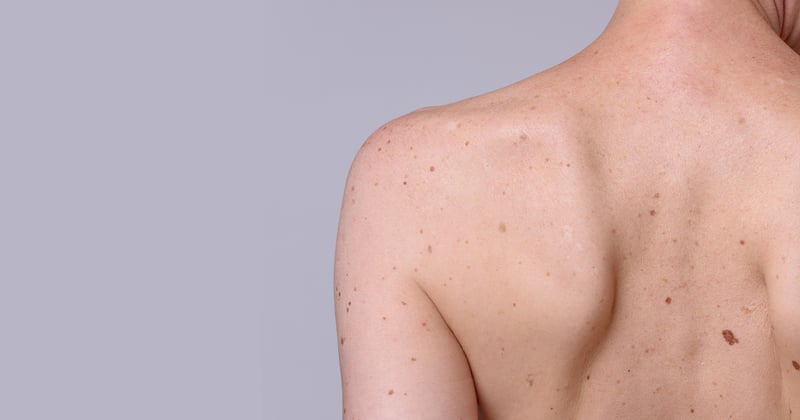

Seborrheic Keratosis
in Mt. Pleasant, IA
What Is Seborrheic Keratosis?
Seborrheic keratosis is a non-cancerous (benign) skin growth. Due to their wart-like appearance – and the fact that most people get them when they’re middle-aged or older – seborrheic keratosis growths are often called the “barnacles of aging.”
But because seborrheic keratosis often looks like a pre-cancerous skin growth (actinic keratosis) or even skin cancer, finding one on your body can cause a lot of concern. Thankfully, seborrheic keratosis growths are harmless.
REQUEST NOWWhat Are the Symptoms of Seborrheic Keratosis?
It’s possible to have just one seborrheic keratosis growth, but most people develop several. Some growths have a wart-like surface, while others look like dabs of candle wax or beeswax on the skin. They tend to start off light tan, then darken to brown or black.
Seborrheic keratosis grows gradually over time and can vary in size (from very small to more than an inch in diameter). Your growth(s) may look like:
• A round or oval-shaped waxy or rough bump
• A flat or slightly-raised bump with a scaly surface
Most seborrheic keratosis growths appear on your face, neck, shoulder, chest, or back, but they can pop up almost anywhere (except your lips, palms, or soles). You may experience itchiness but should have no pain.
What Causes Seborrheic Keratosis?
Despite its appearance, seborrheic keratosis has no relationship to skin cancer and poses no risk to your health. In fact, the condition is mostly hereditary – you inherit the pattern as well as the location(s) where it grows.
Seborrheic keratosis can also occur during pregnancy, after hormone replacement therapy, or because of other medical issues. If you’ve had one seborrheic keratosis, you’re at risk of developing more in the future.
When clothing rubs up against the growths, it can cause them to increase in size. If your growths become irritated or bleed easily, especially under clothing, they should be removed by a dermatologist.
Is Diagnosing Seborrheic Keratosis Difficult?
Not at all. Your Forefront dermatologist can usually identify a seborrheic keratosis simply by looking at it. Sometimes, the growth may have characteristics of skin cancer. If so, the dermatologist will remove it so it can be examined under a microscope – the only way to know for sure if a growth is skin cancer or not.
What’s the Best Treatment for Seborrheic Keratosis?
Cancer concerns aside, you may want to remove your seborrheic keratosis growths for cosmetic reasons or if they keep getting caught on your clothing or jewelry. Local anesthetics can make your treatment painless, and because the growths are superficial, there should be very little scarring.
Your seborrheic keratosis treatment options include:
• Cryotherapy – Your Forefront dermatologist applies liquid nitrogen to the growth with a cotton swab or spray gun, which destroys the growth. It should fall off on its own within days. Sometimes, a blister forms underneath the seborrheic keratosis and then dries into a scab-like crust. The crust should fall off on its own as well.
• Electrocautery and curettage – Your Forefront dermatologist numbs the growth with an anesthetic and uses an electric current to destroy it. Next, we use a curette (a scoop-shaped surgical instrument) to scrape off the treated growth. You will not need stitches, although you may experience minor bleeding. Some patients only need one procedure or the other.
What Happens After Seborrheic Keratosis Removal?
The skin where the growth was may be lighter than the surrounding skin at first, but it should improve in time. Most seborrheic keratosis growths that are removed never return, but you may get a new growth elsewhere.
Where Should I Go for Seborrheic Keratosis Evaluation?
Seborrheic keratosis growths are harmless, but any sort of changing growth on your skin should be checked. Trust our team of board-certified dermatologists to provide you with the expert care you need. Find a Forefront Dermatology office near you and schedule a consultation today.
Is it seborrheic keratosis or something else? Book a consultation with a skin care expert today.
1 Location in the Mt. Pleasant, IA area
Interested in Seborrheic Keratosis? Request a consultation with a skin specialist today.
*Treatment options may vary at each location.Please confirm your desired treatment is offered at your preferred location when scheduling. *Age Restriction.
For patients scheduling who are under 18 years of age (19 in Alabama) please make sure you have permission from your parent or legal guardian to schedule this appointment. Your parent or legal guardian must accompany you on your initial visit and on certain subsequent visits to provide appropriate informed consent.